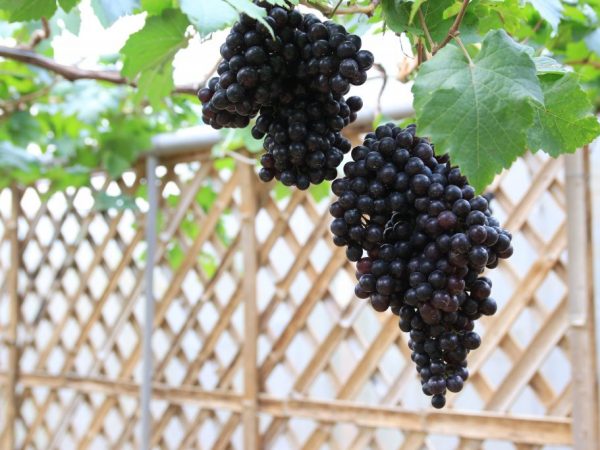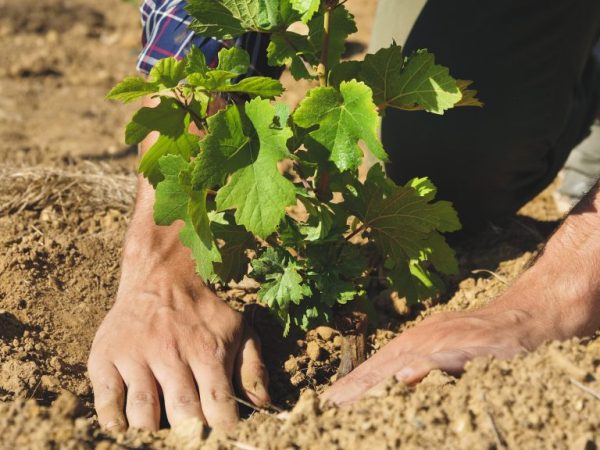Grapes raisins Black Potapenko
Table raisins Black Potapenko is considered one of the best varieties on the market. It was obtained by crossing 2 dessert varieties. A large amount of sugar is felt in its taste. It is better to consume it fresh than to process the fruit to make drinks.

Grapes raisins Black Potapenko
Features of the variety
Kishmish Potapenko black refers to crops with a high growth rate. Kishmish Potapenko is able to withstand temperature drops from -25 ° C to 40 ° C, so it is suitable for growing in all regions of the country.
Description of the bush
The bushes of this variety grow up to 4-5 m. The inflorescences are heterotrophic, which allows the plant to pollinate itself on its own. The shoots are powerful, high. They contain 30 eyes.
According to the description, the leaves of Potapenko's black raisins are large. The average length of a leaf plate is 12 cm, width is 6 cm. At the edges of a dark green leaf, there are 5 lobes and wavy areas. The cross section of the sheet is average.
Saturation of taste and quality of fruits
According to the description, Potapenko's raisins are characterized by high vigor of berry growth. Their average weight is 15 g, and their length is about 2 cm. The surface of the peel is dark blue. The pulp of the berry is juicy, tasty, non-watery.
When considering black grapes Potapenko raisins, the following features of the bunch are noted:
- conical shape;
- weight is 800-1500 g, depending on the quality of care;
- they are genetically protected from cracking and overripening of fruits.
According to the description, the fruit has a high sugar content. Its level reaches 30%, so Potapenko's raisins are used not only for making children's desserts or sweet wine.
Growing rules
The Black Potapenko grape variety is classified as a thermophilic crop. He needs enough sun and warmth. Despite this, planting is best done near hedges so that the plant curls over them. The southern part of the garden is considered an ideal place for planting crops.
Planting, according to the description, is carried out in early April, when the soil is warmed up enough for the introduction of planting material into it. Only mature plants are able to withstand temperature changes. Young seedlings need 2-3 years to take root and become independent of climatic conditions.
The plant of this grape variety thrives in loamy or sandy soils. It is allowed to plant on black soil. If the soil is heavy, 1 bucket of sand is added for each square meter of the area. If the acidity of the earth exceeds 4%, liming is imperative. For 1 sq. m should account for 5 liters of limestone solution (2 kg per 10 liters of water).
Landing features

Only healthy seedlings are suitable for planting.
For the hole, a hole is dug 80x80 cm in size. A small drainage system is made inside for high-quality circulation of water and air.The soil is fed with organic fertilizers: humus, peat or humus. The hole should remain in this state for 2 months in order for the soil to absorb all the beneficial elements.
In the spring, when the soil has warmed up, a seedling is placed inside the hole. It must be vaccinated and free of damaged or diseased areas. Its roots are evenly distributed over the diameter of the hole and sprinkled with earth. The root collar should be at a height of 5 cm from the ground surface. At the end of planting, the culture is watered with 20 liters of warm water. A support is installed nearby, which will protect the tall plant from deformation and shading.
Care rules
During the flowering period, top dressing is applied weekly. Mineral components are used: 20 g of potassium nitrate or 40 g of superphosphate per 10 liters of water. 15 liters of solution are poured under each bush. To improve yield indicators in mid-summer, the plant is fed with nitrogen mineral components. Pour 3 tbsp under each root. l. ammonium nitrate, after which watering is carried out.
The plant of this grape variety needs high-quality watering. This helps protect it from root rot or powdery mildew. The watering interval should be 7-9 days. Use 20 liters of warm water per 1 bush. After watering, the soil is loosened and all weeds that interfere with the development of the bushes are removed.
Pruning is carried out in spring and autumn. In the spring, the shoots are cut so that no more than 8 eyes remain on them. It is not necessary to carry out a full spring pruning, since this will reduce the juiciness of the bunches. In the fall, the crown is thinned out and all diseased areas are removed. During the winter, the plant recovers.
During the first 3 years, regular autumn mulching of the soil with straw and humus is carried out to protect the bushes from hypothermia.
Common diseases and pests
According to the characteristics, the species is less susceptible to diseases and pests than its counterparts.
The variety affects olive spot. Its main symptom is the presence of yellow spots on the surface of the leaf, which, developing, lead to the complete drying of the leaf plate and the death of the plant. Regular spraying of the area with Bordeaux liquid (30 g per 7 liters of water) helps to get rid of it. As a preventive measure, watering is normalized, and the site is regularly cleaned from weeds.
Among the main pests are birds, wasps and flea beetles. Chemical insecticides, which contain copper (40 g of Oxychom per 10 liters of water), help to get rid of flea beetles. Special covering materials in the form of a net are saved from birds. Traps made of honey or jam, which are placed throughout the site, help to get rid of the invasion of wasps.
Conclusion
Potapenko black grapes are considered the best representative of the raisins family. Despite the simplicity of care, it gives the maximum yield.


